Art Fairs
A $66,000 Pair of Scissors (That Don’t Work) + 9 Other Unexpected Treasures at Art Basel Miami Beach 2018
We tracked down a range of standout artworks that merit a second, or even third, look amid the fair's overabundance.
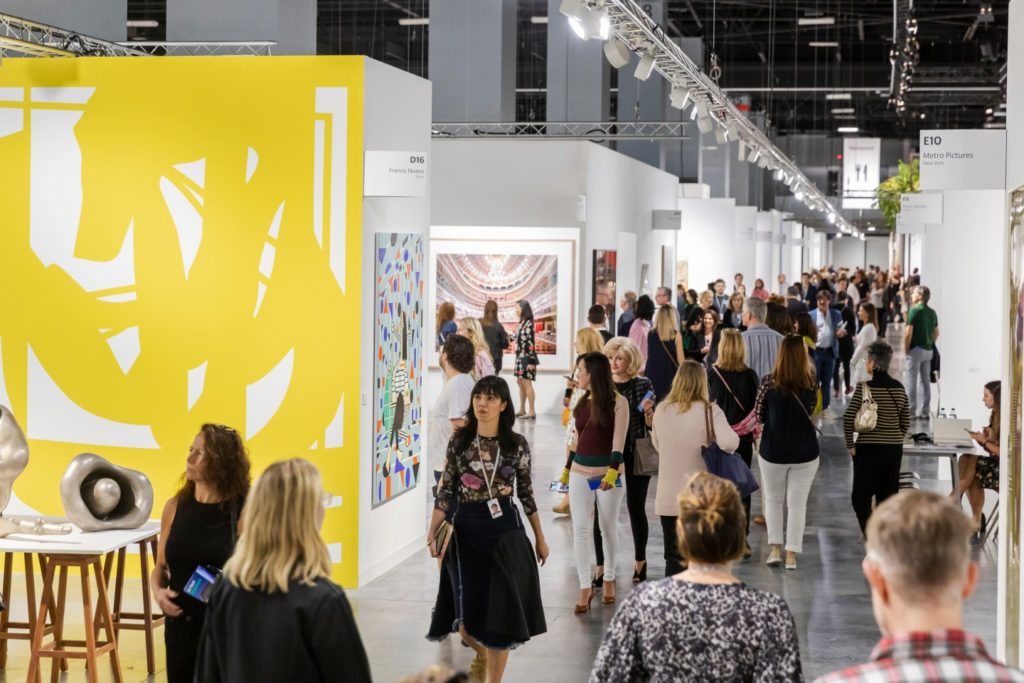
We tracked down a range of standout artworks that merit a second, or even third, look amid the fair's overabundance.

Andrew Goldstein

From Rothkos to Rauschenbergs, Koonses to KAWSes, Art Basel Miami Beach always offers a plethora of billionaire-priced fare from the top of the art market. This year is no exception, with masterpieces hanging alongside pieces by today’s much-hyped brand names.
Alongside these riches, there is also, as usual, a wealth of artworks that make you stop, scratch your head, lean closer, and maybe even reflect—if you’re willing to pause your headlong rush to the mega-galleries, that is. Here are a few standouts that merit a second, or even third, look.
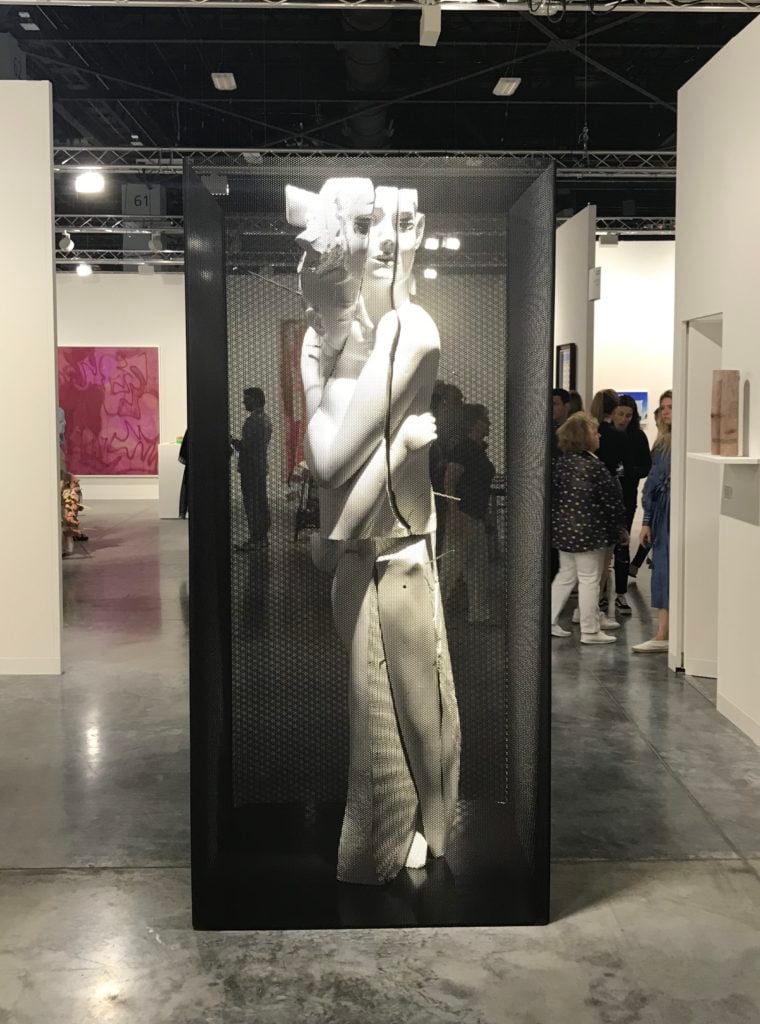
The Los Angeles artist Matthew Monahan has been making his bisected, dissected, and otherwise disassembled homages to ancient statuary for about two decades now, appearing in shows including the New Museum landmark 2017 “Unmonumental” survey and Jeffrey Deitch’s recent “People.” Lately, however, his work has taken a dramatic turn, merging his antique subject matter with a design flourish worthy of Jony Ive: He has begun encasing his sculptures inside matte-black metal screens, which allow only fleeting, evanescent glimpses of the figure inside as you circle the piece.
Debuted at Anton Kern this fall, the sculptures are made even more spectral through a neat trick where Monahan silkscreens blue dots on the sculpture within, confusing the eye and making it difficult to hold a steady focus. Aesthetically, the whole thing amounts to a power move that makes you look at this artist’s work afresh.
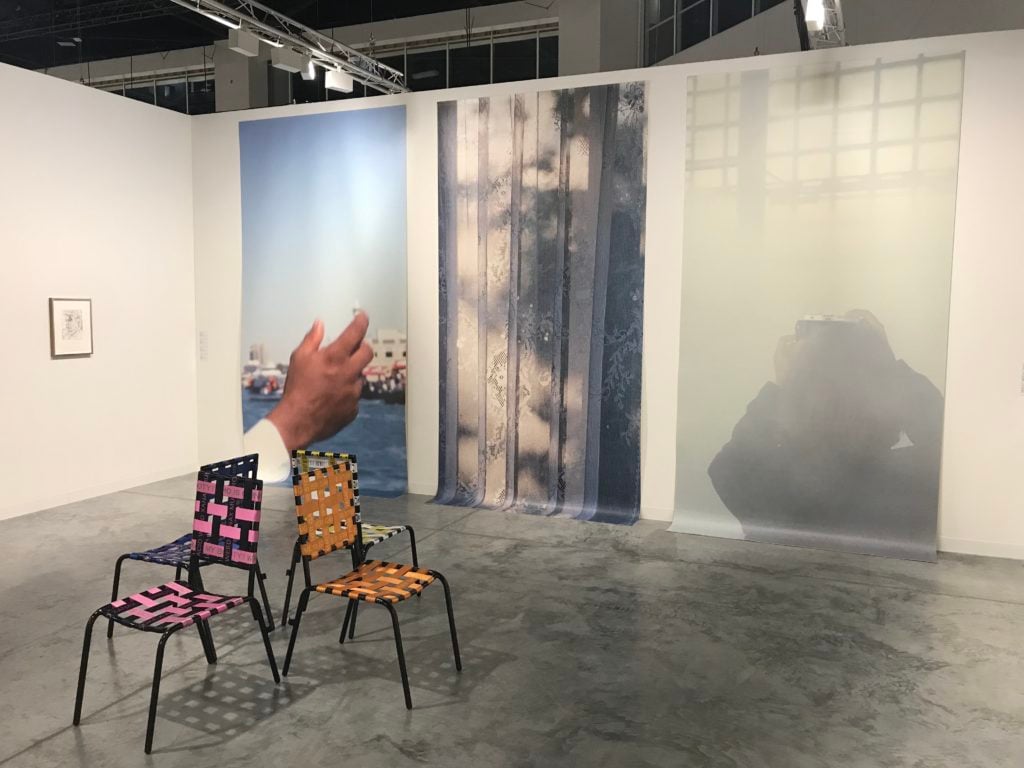
The video-cum-installation artist Martine Syms (buzzed-about as a 2019 Whitney Biennial star) has become such an in-demand sensation that her London gallery, Sadie Coles HQ, literally pulled up the floor of her last show to sell here at Art Basel.
Consisting of three large sheets of dance flooring printed with snapshots from Syms’s wide-ranging travels around the world, the wall pieces—and the woven, text-encrusted chairs in front of them—were last seen in “Grand Calme” at Coles, which used video, wall text, and objects to address the wild ultra-mobile nature of contemporary life. With the recent news that air travel is predicted to double over the next 18 years, Syms’s concerns about global transience are both of-the-moment and prescient. As the artist has said, “When you travel so often it’s sometimes to hard for you soul to catch up with you.”
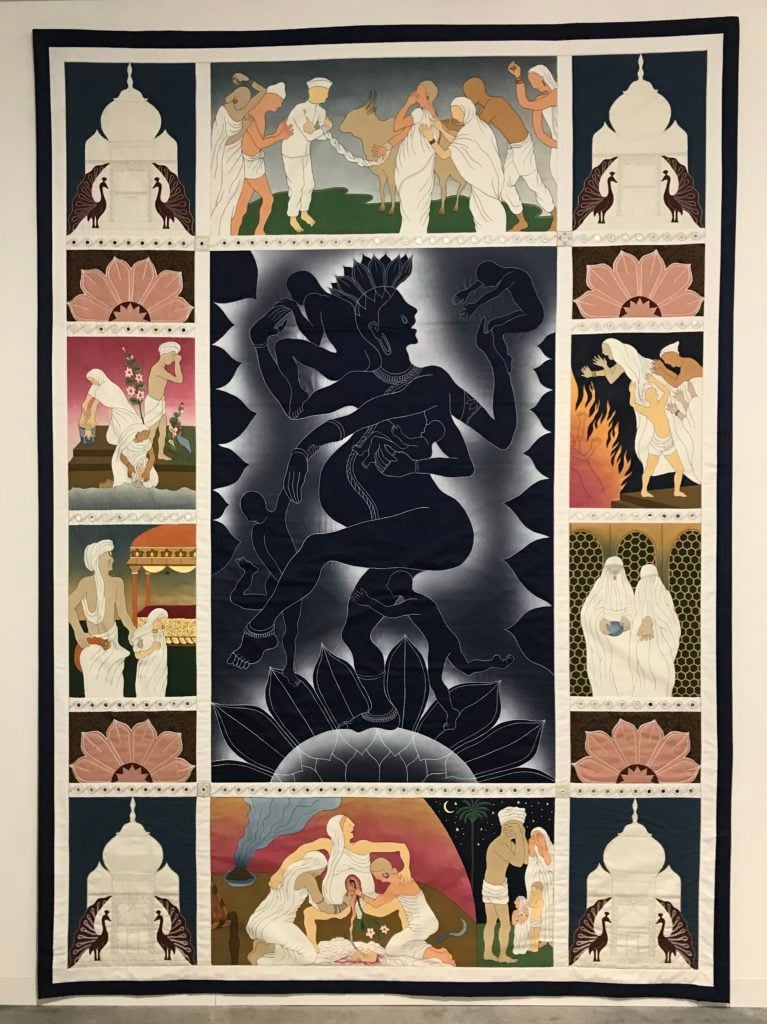
With her new ICA Miami show coinciding with a wave of attention on women with previously under-recognized roles in art history, feminist icon Judy Chicago is now being reappraised as a multidimensional creative force—not just the creator of The Dinner Party.
A potent engine behind this shift is Salon 94, which is here showing a piquant work from 1985, illustrating the global scope of Chicago’s vision. The tapestry is part of the “Birth Project” series, in which the artist—realizing that while there are many famous Western artworks depicting mothers and newborns, there are very few actually devoted to the experience of childbirth itself—sought to find images in other cultures depicting the act.
In the process of creating this piece, Chicago first researched the (often harrowing) history of parturition in India and then teamed with 10 artists to piece together a traditional Indian tapestry showing a pregnant Shiva in the center ringed by scenes of a child marriage, a coerced wedding night, an agonizing childbirth, and then, after the husband’s death, the wife being consigned to the rite of suttee: being burned alive on his pyre.
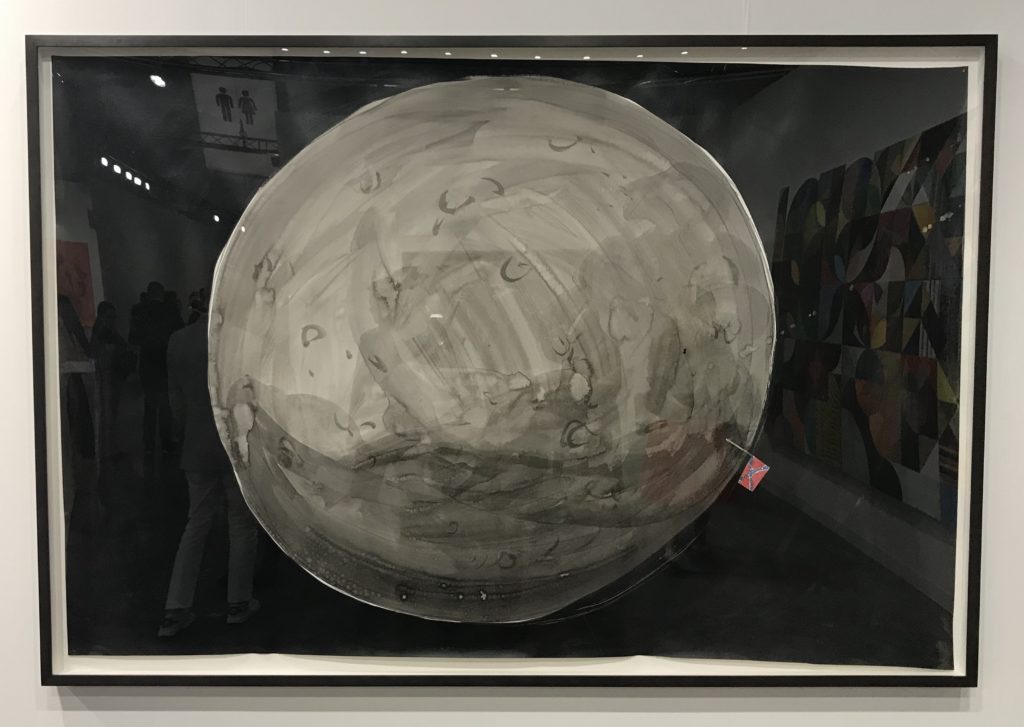
As the debates over Confederate monuments roil America’s south, Kara Walker—one of our great experts on the complex legacy of slavery—has been paying particular attention to the fate of the intensely fraught artworks, even taking her class at Rutgers’s Mason Gross School of the Arts on a visit to Stone Mountain, the grandiose Georgia rock carving celebrating Jefferson Davis, Robert E. Lee, and Stonewall Jackson.
Now, after debuting a steam-powered calliope at Prospect New Orleans that plays black protest music—a collaboration with the pianist Jason Moran—the artist is planning to take the mobile music-player on a tour, planting a consciousness-raising showcase outside of museums commemorating Confederate battlefield victories (again with Jason Moran on the keys).
This watercolor at Sikkema Jenkins’s booth offers another take on the Confederate debate, and one that is profoundly ambiguous. It’s titled Soon, and can be interpreted either as the vanquished Southern army’s followers jettisoned to a cold new home on the moon, or as a triumphant neo-Confederacy finally staking claim to the lunar surface.
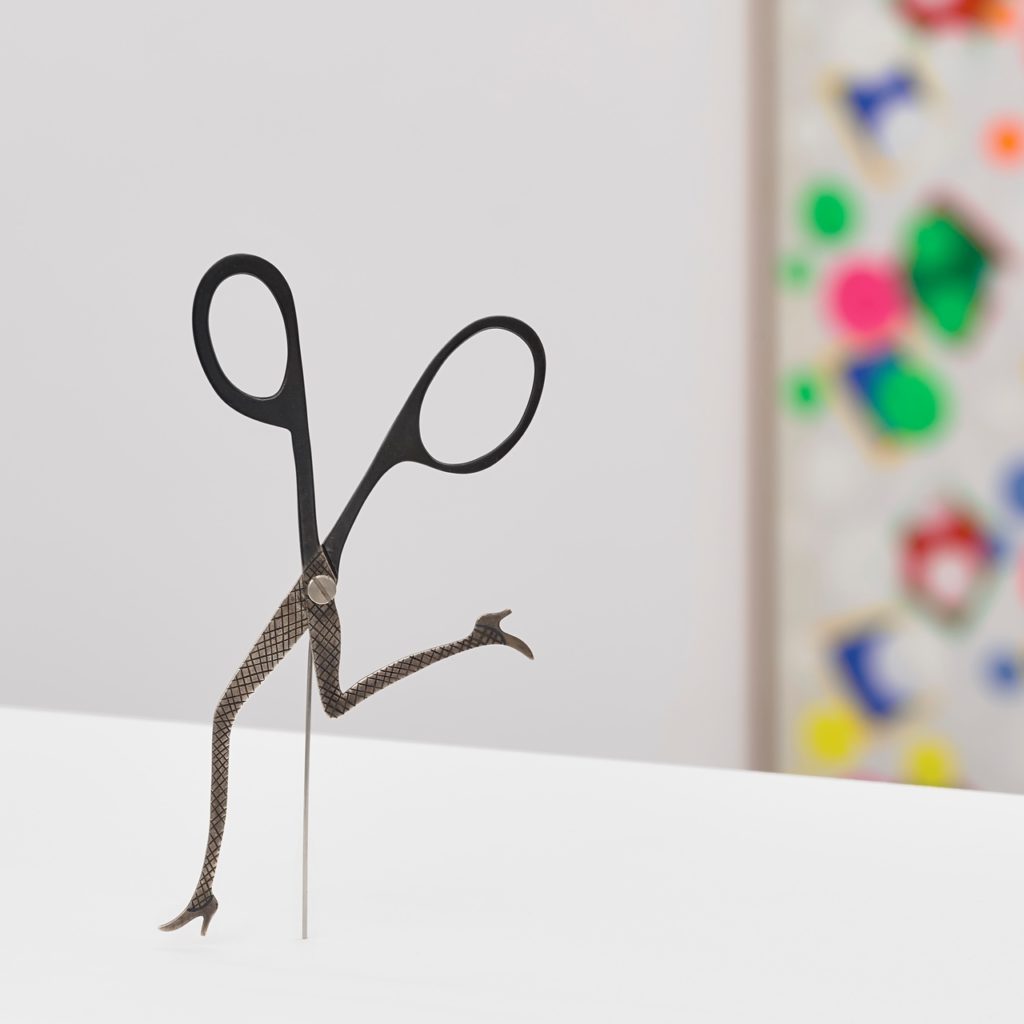
Part of the fair’s Kabinett presentation, Sies + Höke’s spectacular booth focuses on the impact of Gilbert & George’s conceptual art on the artists of the Rhineland, with a special focus on Gerhard Richter, Konrad Lueg, and Sigmar Polke. While other works on view may be more impressive, this little visual pun by Polke is the most surprising. One of the famed painter’s rare sculptures, these sterling-silver scissors—beautifully cast to resemble a slender woman’s fishnet-stockinged legs—were initially intended to be part of an edition of 77, but only 33 were ever made.
A Sigmar Polke superfan, dealer Alexander Sies managed to track this pair down and acquired it to complete the gallery’s ABMB display. It runs away with the show, a slippery piece of wordplay that evokes the notion of running with scissors, and also, perhaps, women’s escape from household chores during the liberating ‘60s era.
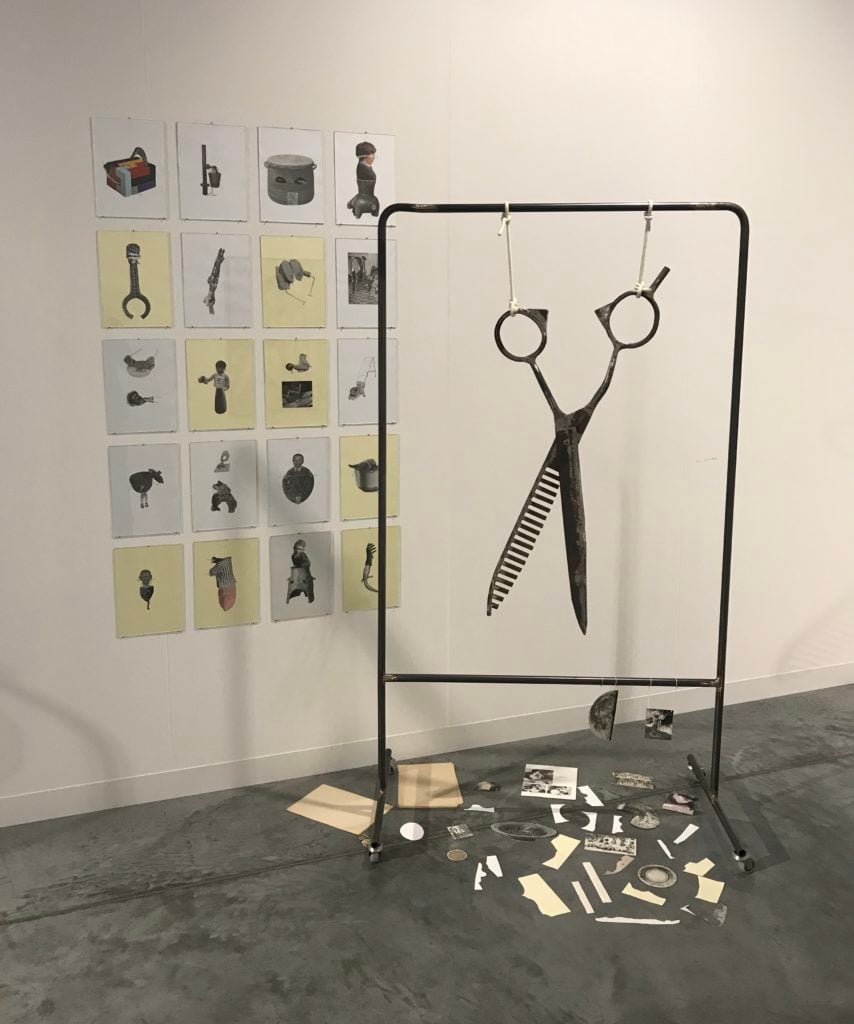
Another, far more overtly feminist take on scissors-as-art can be found a little further on in the fair, where a massively over-sized sculpture of shears hangs aside some yellowing collages of children, with lines x-ing over their eyes, in various stages of distress. At first one might imagine that the display stands as the work of yet another criminally overlooked female artist from the postwar era. But the artist, the Czech sculptor Eva Koťátková, was actually born in 1982—she’s a Millennial!
Koťátková mines the traumas of her country’s long dictatorship, often through meditations on the way oppression seeps into the mind, transforming everyday household objects into totems of terror. (This piece is from her 2017 show at Düsseldorf’s K21 Kunstsammlung NRW, which also featured large screaming buttons and a menacing vegetable grater.)
In 2018, Koťátková took a break from her accelerating art career to take care of a new baby daughter, but she has a big year ahead, with two shows in the works, a nomination for the Zurich Art Prize, and a coveted residency at the Atelier Calder in Saché, France.
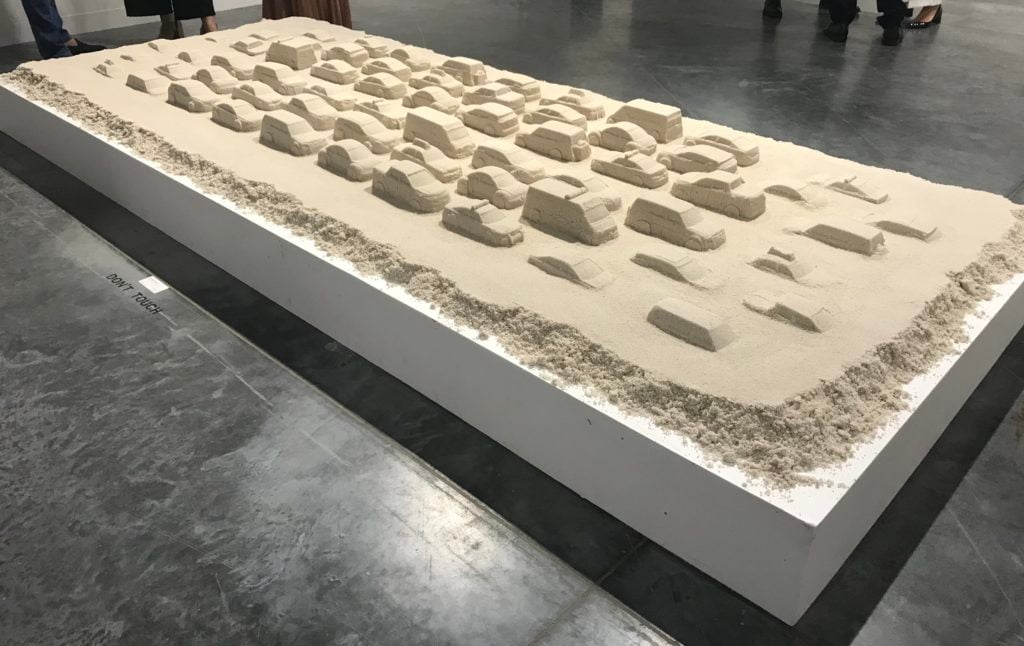
An artist who gas both represented Argentina in the Venice Biennale and appeared in the Whitney Biennial, the Buenos Aires-born artist Leandro Erlich is a master of perceptively wizardry, pushing art beyond the frame to create wondrous, frequently whimsical settings—an optical-illusion townhouse in London where passersby could abandon the laws of gravity, for instance, or ultra-puffy clouds that seem to drift forlornly through grand museums.
At Ruth Benzacar’s booth, the artist has a Miami Beach-appropriate installation where cars—taxis, SUVs, police cars, etc.—have been molded from sand (actually a mix of sand and three types of salt, which form a hardened crust) on a platform, seeming to rise up from nowhere, form traffic jams, and then fade away.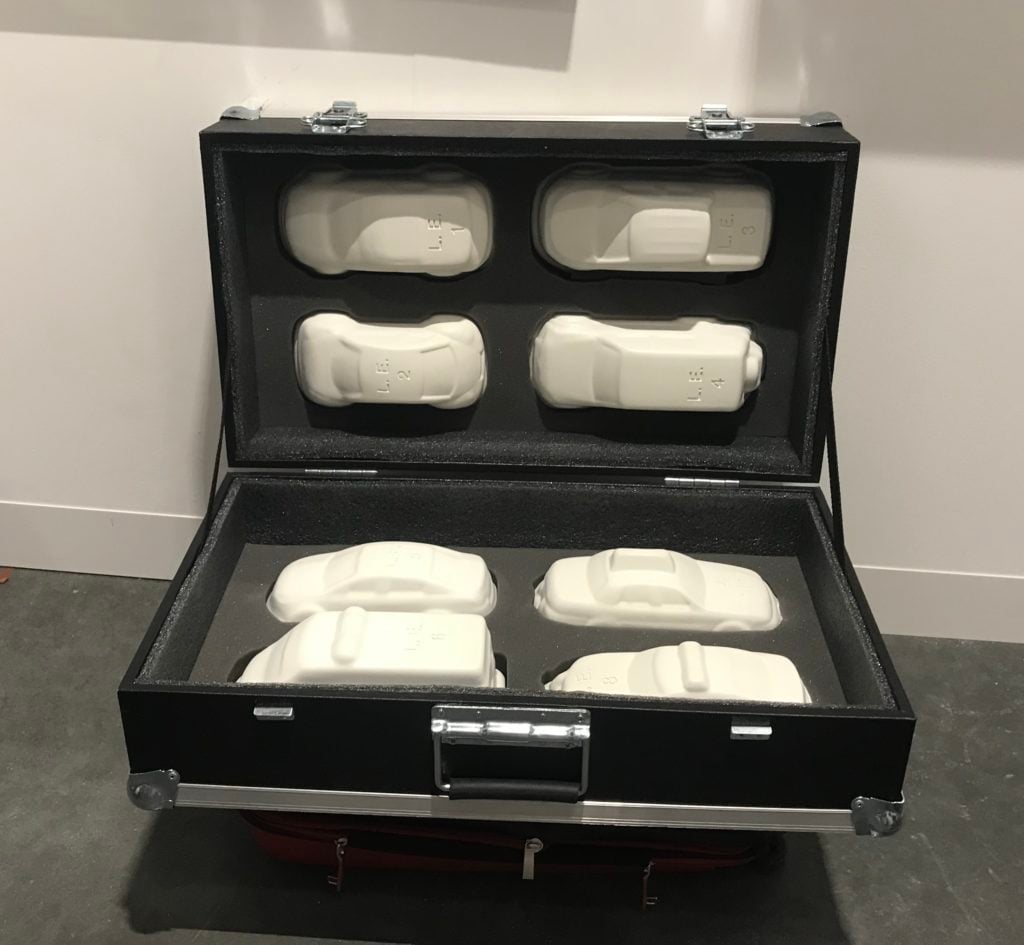
If you were to buy the artwork, you would actually receive a handsome briefcase fitted with eight plastic molds and a protocol for assembling the piece, so that you can assemble it at home yourself. The installation at the fair, however, is essentially a maquette: Next year, Erlich will create a life-size version of his sandy highway on Miami Beach during Art Basel 2019.
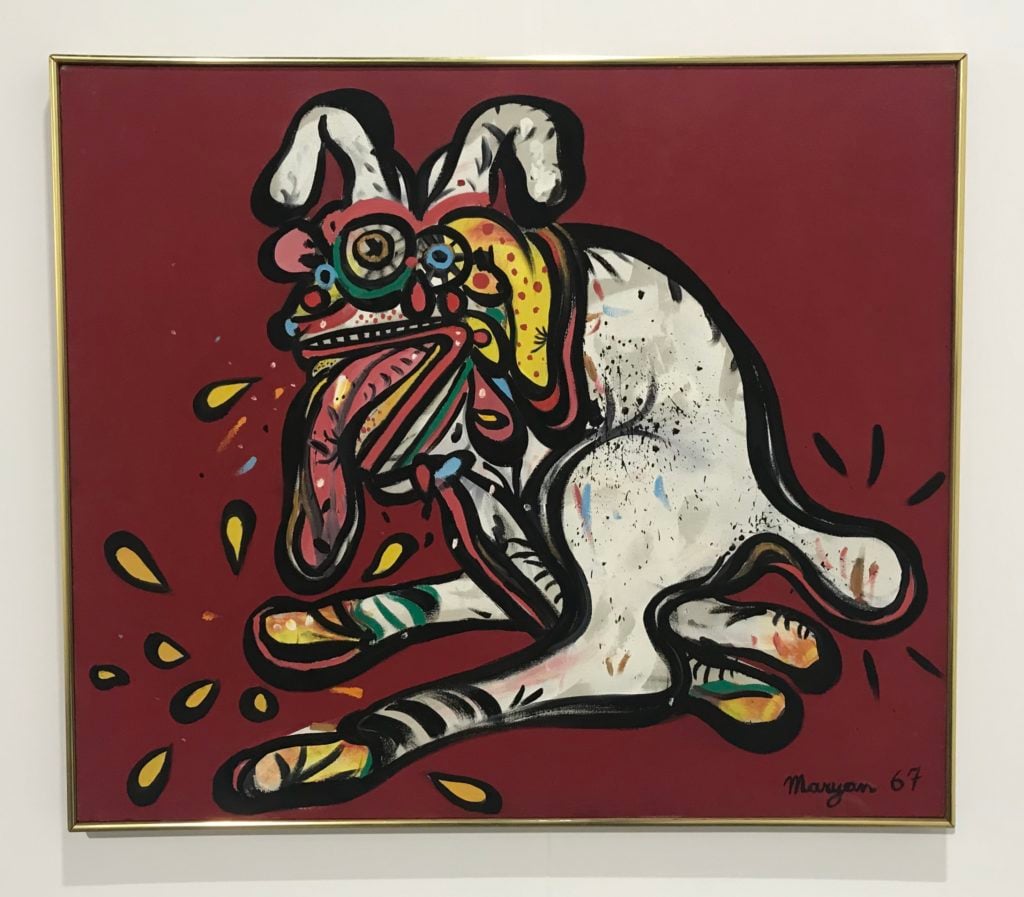
Born in Nowy-Sącz, Poland, Pinchas Burstein was 12 years old when he was sent to Auschwitz. In the final days of the war he was lined up to be shot—but, thanks to the habitual drunkenness of the firing squad, he was left for dead with a neck wound, and was rescued when the Russians liberated the camp. After six years of living in displaced-persons camps, he went to Jerusalem, where he studied art and won a grant to go to the École des Beaux-Arts in Paris, where Léger became his teacher. Upon graduation, he was swiftly picked up by André Emmerich’s white-hot gallery, but, realizing he would never get citizenship, he moved to New York, living and working in the Chelsea Hotel until his death in 1977, going by the name Maryan S. Maryan.
Estate sales of 20th-century art dealers are a great place to hunt for overlooked artists, and the collector and financier Adam Lindemann’s gallery Venus Over Manhattan discovered Maryan when looking through the holdings of the late New York gallerist Allan Frumkin—learning that much of his inventory remained in storage. The artist’s paintings are moody and suggestively violent (Philip Guston was a fan). The dogs Maryan encountered in the death camps are a recurring motif, with everything rendered in a frenzied whirl that recalls a mix of Art Brut and Chaim Soutine.
Thanks to a gallery’s enterprising market approach, Maryan—who has a growing collector base in Israel and Paris, and has been shown at MoMA and the Guggenheim—suddenly may see his stature in art history rise.
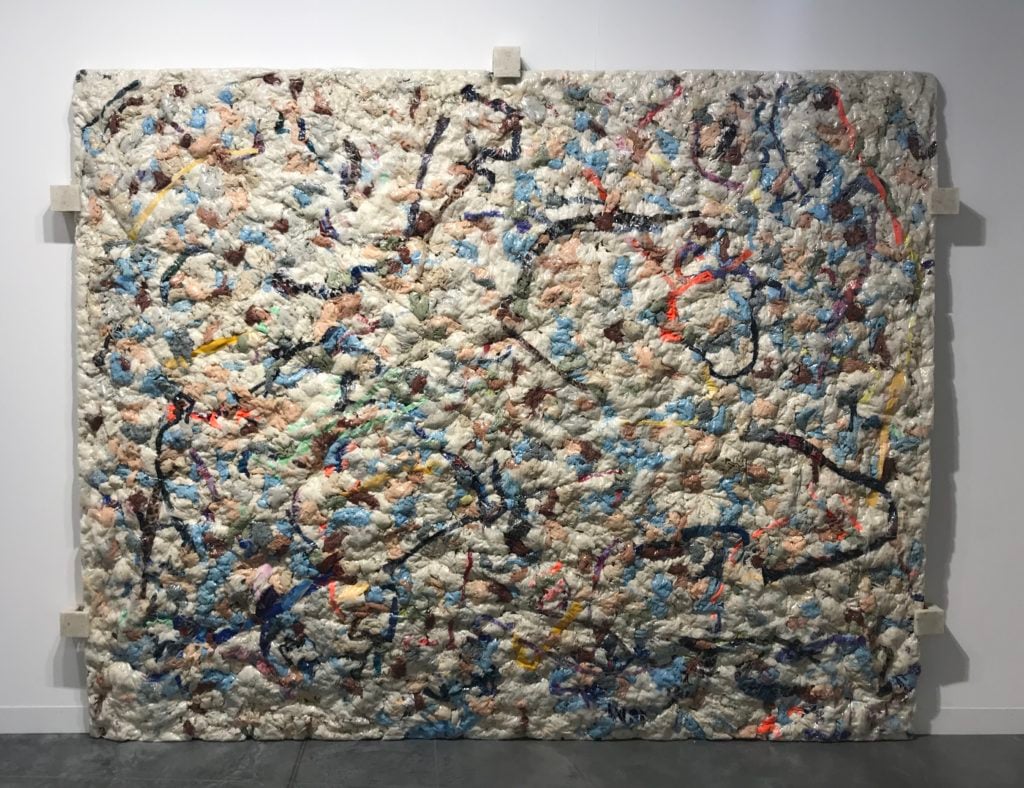
Known as a sound and performance artist, Kevin Beasley has long made work relating to his family’s history in his birthplace of Lynchburg, Virginia—a slave-owning town founded by the brother of Revolutionary War colonel Charles Lynch, whose extrajudicial mode of execution for British loyalists became synonymous with racial terror in the south. While getting his Yale MFA in 2012, Beasley purchased the motor of an old cotton gin from a plant in Maplesville, Alabama (near Selma), and the Whitney Museum is about to showcase this rusted hulk as the center of a bravura sound installation, where visitors can watch the historically freighted machine run in soundproof box, and hear its operations in a separate listening room.
Lately, however, the artist has been moving away from his focus on sound, as can be seen in a pair of impressive “slabs” (as he calls them) at Casey Kaplan’s booth. Made from fistfuls of raw cotton mixed with house dresses and caftans—the clothes Beasley remembers his grandmother wearing—the composition is finished with a resin coating to appear like something Jackson Pollock might have made, if he had a different family legacy.
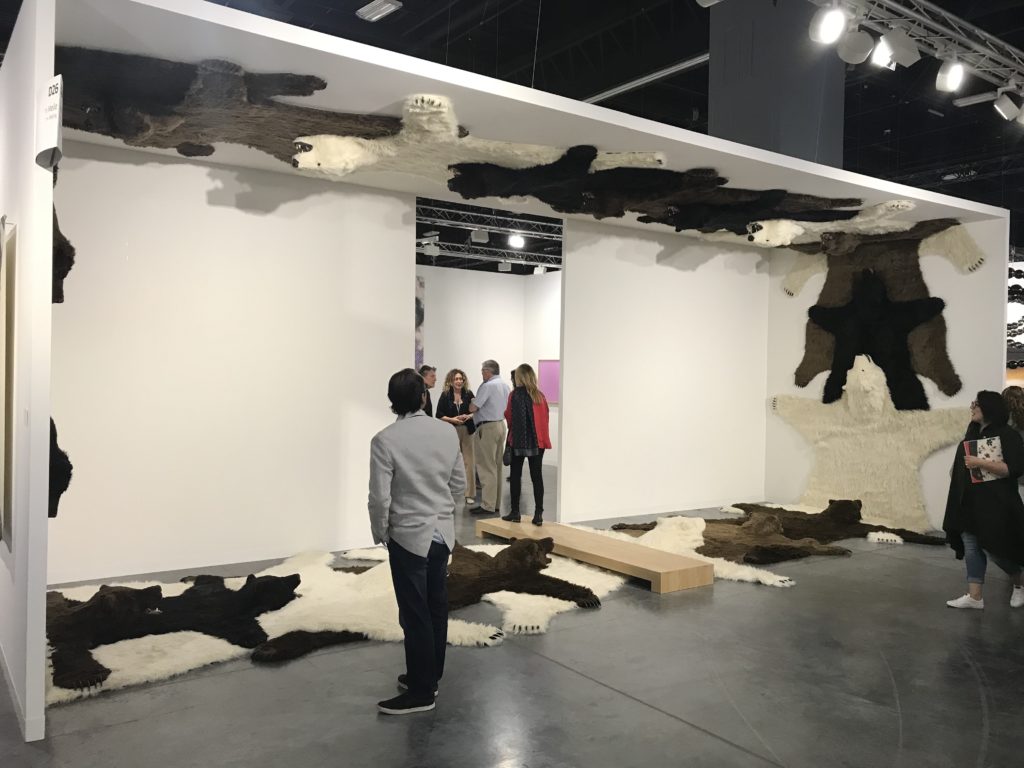
The Italian artist has been working with animals ever since she encountered two unlikely ostriches on the island of Alicudi, off the coast of Sicily, and decided to photograph them in a little dinghy. Since then, she has become famous for her surrealistic work with animals, which spans her photographs of live creatures in strange predicaments (like zebras on a snowy mountaintop), and fake stuffed ones that cavort in her playful sculptures, dyed in all the colors of the rainbow.
At Perrotin’s booth, however, another side of Pivi comes forward in a ring of 24 bearskins that circle a room, floor-to-ceiling, mouth-to-tail, like an ursine ouroboros.
Upon first seeing it, one is seized by a sense of revulsion—so many animals died for this? Then, realizing that the convincing rugs aren’t real, they suddenly appear cuddly and friendly. Dimensions vary, so you could install this in your house—preferably around a cozy hearth.